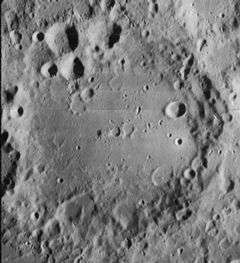Maginus (crater)
|
Lunar Orbiter 4 image | |
| Coordinates | 50°00′S 6°12′W / 50.0°S 6.2°WCoordinates: 50°00′S 6°12′W / 50.0°S 6.2°W |
|---|---|
| Diameter | 194 km |
| Depth | 4.3 km |
| Colongitude | 7° at sunrise |
| Eponym | Giovanni A. Magini |
Maginus is an ancient lunar impact crater located in the southern highlands to the southeast of the prominent crater Tycho. It is a large formation almost three quarters the diameter of Clavius, which lies to the southwest. Just to the north of Maginus is the smaller crater Proctor, and to the southeast is Deluc.
The rim of Maginus is heavily eroded, with impact-formed incisions, and multiple overlapping craters across the eastern side. The wall is broken through in the southeast by Maginus C, a worn crater. Little remains of the original features that formed the rim of Maginus, and it no longer possesses an outer rampart. The floor is relatively flat, with a pair of low central peaks.
Satellite craters
By convention these features are identified on lunar maps by placing the letter on the side of the crater midpoint that is closest to Maginus.
| Maginus | Latitude | Longitude | Diameter |
|---|---|---|---|
| A | 48.8° S | 4.4° W | 14 km |
| B | 52.4° S | 6.2° W | 12 km |
| C | 51.7° S | 9.4° W | 42 km |
| D | 47.9° S | 2.2° W | 40 km |
| E | 49.0° S | 1.4° W | 37 km |
| F | 48.9° S | 8.2° W | 18 km |
| G | 48.0° S | 7.6° W | 23 km |
| H | 52.5° S | 10.0° W | 15 km |
| J | 49.9° S | 2.8° W | 8 km |
| K | 47.4° S | 3.9° W | 31 km |
| L | 49.2° S | 8.9° W | 11 km |
| M | 50.4° S | 9.3° W | 10 km |
| N | 48.5° S | 9.0° W | 24 km |
| O | 50.6° S | 12.6° W | 12 km |
| P | 50.7° S | 11.8° W | 10 km |
| Q | 50.8° S | 2.3° W | 9 km |
| R | 48.9° S | 10.4° W | 9 km |
| S | 49.7° S | 1.4° W | 13 km |
| T | 52.3° S | 7.1° W | 6 km |
| U | 47.4° S | 8.2° W | 9 km |
| V | 49.3° S | 7.3° W | 9 km |
| W | 49.3° S | 7.8° W | 8 km |
| X | 51.3° S | 7.6° W | 7 km |
| Y | 51.8° S | 9.1° W | 7 km |
| Z | 50.2° S | 3.6° W | 18 km |
References
- Wood, Chuck (December 27, 2006). "A Little Clavius". Lunar Photo of the Day. Retrieved 2007-01-04.
- Andersson, L. E.; Whitaker, E. A. (1982). NASA Catalogue of Lunar Nomenclature. NASA RP-1097.
- Blue, Jennifer (July 25, 2007). "Gazetteer of Planetary Nomenclature". USGS. Retrieved 2007-08-05.
- Bussey, B.; Spudis, P. (2004). The Clementine Atlas of the Moon. New York: Cambridge University Press. ISBN 978-0-521-81528-4.
- Cocks, Elijah E.; Cocks, Josiah C. (1995). Who's Who on the Moon: A Biographical Dictionary of Lunar Nomenclature. Tudor Publishers. ISBN 978-0-936389-27-1.
- McDowell, Jonathan (July 15, 2007). "Lunar Nomenclature". Jonathan's Space Report. Retrieved 2007-10-24.
- Menzel, D. H.; Minnaert, M.; Levin, B.; Dollfus, A.; Bell, B. (1971). "Report on Lunar Nomenclature by the Working Group of Commission 17 of the IAU". Space Science Reviews. 12 (2): 136–186. Bibcode:1971SSRv...12..136M. doi:10.1007/BF00171763.
- Moore, Patrick (2001). On the Moon. Sterling Publishing Co. ISBN 978-0-304-35469-6.
- Price, Fred W. (1988). The Moon Observer's Handbook. Cambridge University Press. ISBN 978-0-521-33500-3.
- Rükl, Antonín (1990). Atlas of the Moon. Kalmbach Books. ISBN 978-0-913135-17-4.
- Webb, Rev. T. W. (1962). Celestial Objects for Common Telescopes (6th revised ed.). Dover. ISBN 978-0-486-20917-3.
- Whitaker, Ewen A. (1999). Mapping and Naming the Moon. Cambridge University Press. ISBN 978-0-521-62248-6.
- Wlasuk, Peter T. (2000). Observing the Moon. Springer. ISBN 978-1-85233-193-1.
